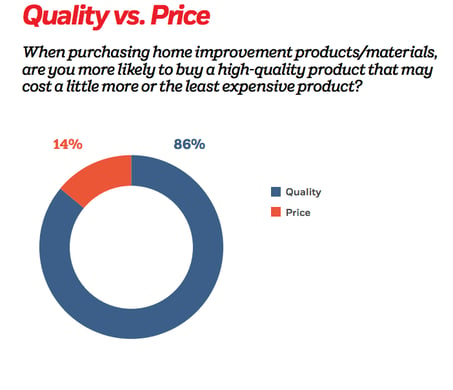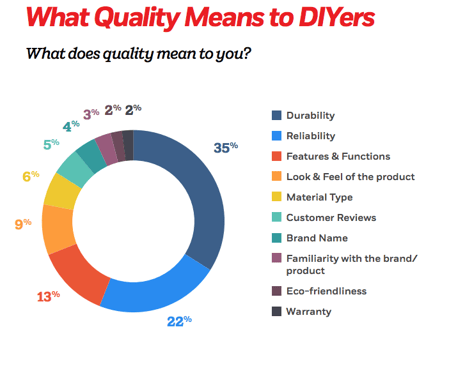
When you're crafting stories about your brand, it's always in your best interest to be as truthful and objective as possible. However, the words you use to describe your products can mean different things to different people, which makes objectivity a lofty goal to reach for. When it comes to modern makers, words like "best" and "quality" are generally up for interpretation.
Quality could pertain to materials for some makers, to reliability for others, and dozens of other standards for the rest. So how do you know which interpretation of "quality" to promote? If you're looking to compete in your market, your best bet is probably to encapsulate multiple meanings of quality that matter within the critical Maker Movement (read more about the impact of the movement here).
To learn about different perceptions of quality and how they influence buyers, keep reading.
What is Perceived Quality?With all our knowledge and memories to back up our observations, it's nearly impossible for us humans to consider anything independent of the influence of our perceptions. In light of that nugget of wisdom, we might define perceived quality as a subjective measure of quality based on the needs, experience, and expectations of a customer.
This belief comes from a conglomeration of sources that impact how your product is perceived, including standards of quality like good craftsmanship, design, function, and more (so don't think you can forego those standards and maintain a good perception). At the same time, quality is only legitimate when it's backed by actual facts and experiences. We would never recommend saying something about your product that simply isn't true. But it's not enough to just have the best product, you've got to make sure people truly believe you do.
An article on Branding Strategy Insider quotes business professor David Aaker when it comes to the elements that affect a consumer's measure of perceived quality, saying the perception is "generated by each buyer’s perception of up to seven elements. In evaluating these quality elements, consumers literally make up their mind about whether what you’re saying matches the qualities they’re seeing."
.png?width=320&name=7-elements-of-perceived-quality%20(1).png)
Makers may not judge every element here, and they may have individual interpretations of those terms as well, but Aaker's theory at least gives us an idea of where the elusive customer perception of quality comes from. In the next section, we'll connect this theory with concrete data collected from real makers to see what quality really means to them.
How Modern Makers Perceive Quality
In 2015, building materials marketers Venveo conducted a study on the demographics and preferences of home improvement DIYers - one of the largest segments in The Maker Movement. A section of the study was dedicated to researching what "quality" means to makers, and how important quality is to them. The results, as we're about to discuss, support the reality behind Aaker's theory on the perception of quality.
First, the participants were asked what is more important in a product they're considering purchasing: quality or price. Eighty-six percent of respondents replied that quality plays a bigger role than price in their buying decisions. This research allows us to deduct that in general, makers value the "quality" (whatever that might mean) of a product, and they're probably willing to pay a little bit more to get it if they have to.

Venveo also asked the participants in the study, "What does quality mean to you?" It seems Venveo and their clients were facing the very same dilemma we've been describing: how do makers tend to interpret the word "quality" when there are so many possible definitions of the word?
The results of the question strike a chord with Aaker's perceived quality theory, as over half of the responses defined quality as a measure of "durability" or "reliability" - two elements straight from Aaker's list. From this data, we could draw the conclusion that makers determine a product's perceived quality by its ability to last a long time and to work the way it's supposed to.

Participants also reported to equate quality with features 13 percent of the time, reflecting another of Aaker's seven evaluation elements. Makers, in that case, appear to also value products with specific or differentiating features and functions that fit their personal needs.
Leverage the Perceived Quality Modern Makers Need
Venveo's research gives us a good idea of the types or definitions of "quality" makers are looking for: reliability, durability, and usefulness of features. For the purposes of building an overall perception of quality for your product, these characteristics are a good place to start. Again, that means you've got to make sure your customers really believe your product is reliable, durable, and has beneficial features.

So, how do you start to build and strengthen that belief within the community of makers? We'd say the first step is to listen to what they're saying about your product. Direct feedback is certainly useful for determining what customers really think about your product, but remember that there are other conversations about your product going on between makers. Being tuned in to conversations about your product and in your target industries is the best way to learn what people perceive about your product. Then, you can emphasize and expand on those perceptions.
All this matters because you might be missing out on significant traffic because your definition of quality doesn't equate with the quality your customers value. What we're really saying here is that the measures of quality that matter to your customer influence how they perceive your product, and by listening to what they want, you can market the product in a way that matches up.




